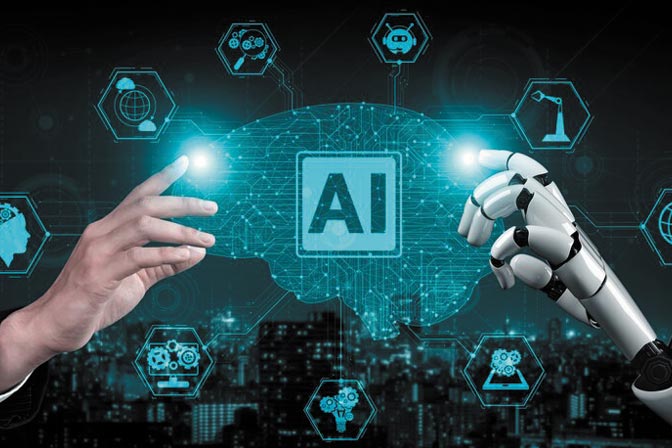Hello Everyone Let’s discuss today onwards about what are the use cases of AI for Developers and Business with AWS Cloud
It’s important to know about the use cases for everything what you learn so, we drive into artificial intelligence (AI) in AWS, and it will be helpful for all the sectors in the world……..!
Artificial Intelligence (AI) is rapidly transforming the way we live, work, and interact with technology. From virtual assistants to self-driving cars, AI is revolutionizing industries and enabling new possibilities. As businesses and developers embrace this technological revolution, Amazon Web Services (AWS) offers a comprehensive suite of AI services and solutions to unlock the power of AI.
First start for Developers Criteria
AI use cases for Developers
Natural Language Processing (NLP):
NLP is a branch of AI that deals with the interaction between computers and human language. AWS services like Amazon Comprehend and Amazon Transcribe enable developers to build applications that can understand and process natural language. This opens up opportunities for sentiment analysis, text summarization, and language translation, among other use cases.
Compute:
First there is the compute required to run large language models (LLMs). Amazon has two specialized chips for this very purpose. Details are as follows:
- AWS Inferentia and AWS Trainium are purpose-built ML accelerators that AWS designed from the ground up.
- The first-generation of AWS Inferentia delivers significant performance and cost-savings benefits for deploying smaller models. AWS Trainium and AWS Inferentia2 are built for training and deploying ultra-large generative AI models with hundreds of billions of parameters.
Build Your own models:
Next, you can build your own models using Amazon SageMaker Jumpstart. Details are as follows:
- You can use Amazon SageMaker along with the purpose-built AWS Trainium chip to train your own LLMs.
- Alternatively, choose one of the language models available in SageMaker Jumpstart and retrain it with your own data.
Foundation Model:
Finally, there are the models themselves. FMs with billions of parameters require time and resources to pretrain. Why build your own FM when you can take advantage of the leading FMs already on the market? Considerations are as follows:
- Amazon Bedrock is a fully managed service that makes FMs, including Amazon Titan models, from leading AI startups and Amazon available through an API. Customers can choose from a wide range of FMs to find the model that is best suited for their use case.
- Amazon Bedrock is the most efficient way to build and scale generative AI applications with FMs.
Conversational AI:
Conversational AI involves building intelligent chatbots and virtual assistants that can engage in natural language conversations. AWS services like Amazon Lex and Amazon Polly enable developers to create voice-enabled applications and chatbots that can understand and respond to user queries in a human-like manner.
AI use cases for Businesses
Generative AI has the potential to bring about sweeping changes to the global economy.
The future forecasts to be a period of intense experimentation. We expect new architectures to arise in the future, and this diversity will set off a wave of innovation. Generative AI will play a transformational role in every industry.
Healthcare:
Generative AI contributes to healthcare in the following ways:
- AWS Health Scribe: empowers healthcare software vendors to build clinical applications that automatically generate clinical notes by analyzing patient-clinician conversations.
- Personalized medicine: By generating treatment plans based on a patient’s specific genetic makeup, lifestyle, and disease progression, AI can contribute to more effective, personalized care.
- Medical imaging: AI can enhance, reconstruct, or even generate medical images, like X-rays, MRIs, or CT scans, which can aid in better diagnosis.
Life sciences:
Generative AI contributes to life sciences in the following ways:
- Drug discovery: AI can generate new potential molecular structures for drugs, accelerating the process of drug discovery and reducing costs.
- Protein folding prediction: AI can predict the 3D structures of proteins based on their amino acid sequence, which is crucial for understanding diseases and developing new therapies.
- Synthetic biology: AI can generate designs for synthetic biological systems, such as engineered organisms or biological circuits.
Financial services:
Generative AI contributes to financial services in the following ways:
- Fraud detection mechanisms: Generative AI can help create synthetic datasets to improve AI/ML systems by simulating various money-laundering patterns.
- Portfolio management: Generative AI can simulate various market scenarios and help in the creation and management of robust investment portfolios.
- Debt collection: AI can generate the most effective communication and negotiation strategies for debt collection, increasing the rate of successful collections.
Across the banking industry, for example, AI technology can deliver value equal to an additional $200-$340 billion annually if the use cases above are fully implemented.
Manufacturing:
Generative AI contributes to manufacturing in the following ways:
- Product design: Generative AI can be used to create new product designs based on set parameters and constraints. It can generate multiple design options and optimize for factors like cost, materials, performance, and so forth.
- Process optimization: AI can generate the most efficient production processes by modeling different scenarios and optimizing for variables such as cost, time, resource usage, and so forth.
- Preventative maintenance: By analyzing historical production data, AI can predict maintenance schedules that will provide the most efficient machine outputs and reduce downtimes.
- Material science: AI can help generate new material compositions with desired properties.
Retail:
Generative AI contributes to retail in the following ways:
- Pricing optimization: Generative AI can model different pricing scenarios to determine optimal pricing strategies that maximize profits.
- Virtual try-ons: AI can generate virtual models of customers for virtual try-ons, improving the online shopping experience.
- Store layout optimization: AI can generate the most efficient store layouts to improve the customer shopping experience and boost sales.
- Product review summaries: AI can generate review summaries for products so consumers can quickly find pertinent information.
In retail and consumer packaged goods, the potential generative AI impact is significant at $400 billion to $660 billion a year.
Media and entertainment:
Generative AI contributes to media and entertainment in the following ways:
- Content generation: Generative AI can be used to create scripts, dialogues, or even complete stories for films, TV shows, and games.
- Virtual reality: Generative AI can create immersive and interactive virtual environments for games or simulations.
- News generation: AI can generate news articles or summaries based on raw data or events.
Conclusion:
AI is transforming the way we live and work, and AWS provides a powerful suite of services and tools to unlock its potential. Whether you’re a developer building innovative applications or a business seeking to optimize operations and enhance customer experiences, AWS AI services can help you achieve your goals. Embrace the future of AI and explore the possibilities with AWS today.
- By admin





